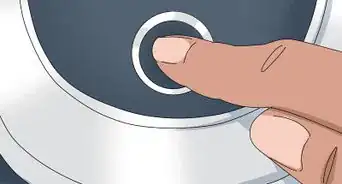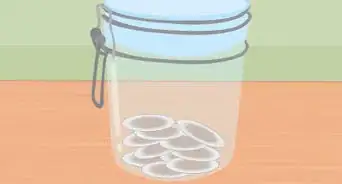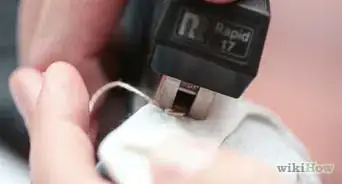This article was co-authored by Jaden Zhao. Jaden Zhao is a Barista and the Owner of Jiaren Cafe & Yoga Studio in Santa Clara, California. Her cafe specializes in matcha drinks, espresso, coffee, fruit drinks, and herbal drinks. Additionally, the cafe hosts classes and features a yoga studio and a community space. Jaden earned an MS from Santa Clara University Leavey School of Business and a BA from the University of Wisconsin-Madison.
There are 19 references cited in this article, which can be found at the bottom of the page.
wikiHow marks an article as reader-approved once it receives enough positive feedback. This article has 13 testimonials from our readers, earning it our reader-approved status.
This article has been viewed 858,710 times.
Automatic coffeemakers may be quick and convenient, but nothing beats the French press for flavor intensity, as well as style. By allowing the coffee grounds to mingle with the water, it creates a stronger, thicker and more piquant cup of coffee, retaining essential oils and sediments that would otherwise get caught up in drip coffee maker's filters. If you've got one languishing in your cupboard, dig it out, clean it and follow these easy steps for a fresh new cup of coffee.
Steps
Gathering Your Supplies
-
1Choose the right bean. With dozens of beans available at local coffee shops and supermarkets, it can seem impossible to narrow down your search for the perfect coffee bean. Thankfully, a few criteria can help you choose the best bean for your preferred palette.[1]
- If you want a coffee with high caffeine levels, choose one that is a light roast. Contrary to popular belief, the darker a roast of coffee does not increase the amount of caffeine it has, but rather decreases it. The darker a coffee bean is, the longer it has been roasted, and the more of the beans’ natural caffeine has been burnt out. So, to help keep you awake longer find a light-roast coffee.[2]
- Decide on how rich a flavor you want. Although each roast differs, typically dark roast beans are known for a deep, full flavor. Light roasts are a little less bitter tasting and have sweeter undertones. If you are new to coffee and are afraid of the “burnt” taste of beans, choose a light roast. If you are a coffee connoisseur with years of experience, then a light or dark roast is a good option.
- Make sure your beans are a coarse ground. Unlike espresso and drip coffee pots which require a fine ground for coffee, you want to have your beans in larger granules. This means that instead of being the consistency of a powder, your coffee beans will be closer to the consistency of sand.
- Always use fresh beans. No matter what method of coffee brewing you use, it is imperative that you always use fresh beans. Old, stale beans lose flavor and give your cup of coffee a bad taste. Buy your coffee beans in two week batches (enough to last only two weeks at a time), and always grind your beans immediately before brewing.
-
2Get your French press.[3] A French press is a type of coffee pot formed by a large glass cylinder with a flat filter attached to a long pull/handle on the lid. This allows you to place your coffee grounds in the bottom, place the filter over the top, and add hot water.
- Although some people complain about having a lot of grinds in their coffee as the result of a French press, this more likely has to do with the grind of the coffee itself. If it is too fine or of irregular size, it will go through the filter and into your hot water.
- French presses also go by the name of “Cafetiere.”
Advertisement -
3Get a good grinder. Nearly as important as the French press itself is a good coffee bean grinder. Find a conical burr grinder rather than going budget with a cheap version. The grinder is responsible for breaking up the whole coffee beans into the perfect size grains, and in revealing the coffee’s true flavor.[4]
-
4Gather other supplies. You will need boiling water to make the coffee and mugs to pour it in, otherwise the rest is up to you! Feel free to add your favorite sweeteners to your coffee whether they be sugar, honey, caramel, or chocolate in addition to half and half cream.[5] Or go purist and drink your cup of coffee black, for a rich, deep flavor.
Brewing Coffee with a French Press
-
1Preheat your coffee press. Although you don’t need to add any water at this point, it is good to run your press under warm water. Because the majority of your press is made of glass, pouring boiling water into it might crack the glass, ruining it. Just make sure the glass is slightly warm to the touch before brewing your coffee.
-
2Grind your coffee. It is imperative that you always grind your coffee right before you brew it, to get the best flavor and prolong how long it lasts before going stale.[6]
- If you want to make one cup of coffee, then you need to grind enough for one heaping tablespoon of grounds.
- Continue adding additional tablespoons of grounds for more cups of coffee.
- While you are grinding your coffee, begin boiling your water in a separate pot. You can do this in a regular stove-top teakettle or an electric teakettle. The perfect temperature for French press coffee is from 195–200 °F (91–93 °C).[7]
-
3Put the coffee in the press. Take off the lid from the French press. This should remove the plunger with the attached filter. Pour the desired amount of coffee grounds into the bottom of the glass.
-
4Add the water. Once you have secured the filter over the grounds, pour your boiling water into the press. Add one cup of boiling water for each cup of coffee you desire to end up with. Lift up the plunger and stir the grounds with the water to help extract the coffee into the boiling water.
-
5Wait. Leave the press with the plunger up so that the grounds can continue to interact with the hot water. You can set a timer to make sure you allow it to set for the right amount of time; 3-4 minutes is the perfect amount of steeping time.[8]
-
6Finish the coffee. Once the time is up, press down the plunger to separate the grinds from the water. Be sure to press down with a slow and steady pace to avoid mixing up the grounds or sloshing the coffee everywhere. Then, finish by pouring into your favorite coffee mug. Enjoy![9]
Brewing Tea with a French Press
-
1Select your tea. You can choose any loose-leaf tea with large enough leaves that it won’t sneak through the filter. Another option is to cut open a bag of your favorite pre-bagged tea and pour it directly into your French press. For every one cup of tea, add one tablespoon of tea leaves.
- Green teas are full of antioxidants and health benefits.[10] For an energy producing cup of tea, choose a green tea or mix that includes green tea.
- For a simple, pure cup of tea, try a white tea. These are the least processed of all the tea varieties and offer a light, sweet taste. White teas also have ties to improved complexion and skin health.
- Black tea is a dark, rich tea with a full flavor. Traditional black teas include earl gray and English breakfast tea, but there are many other varieties available.[11]
- If you want a flower based tea, try a herbal tea. These are often caffeine free and aid in digestion. Popular herbal teas include chamomile and peppermint.[12]
- For an energy boost similar to coffee, try a mate tea. These give a cup full of good-for-you vitamins in addition to a great taste and bit of caffeine.[13]
- Oolong teas are a strong tea popular in China.[14] These are often likened to black teas, and can be found in a variety of flavors.
-
2Boil your water. On a stove or with an electric teakettle, boil one cup of water per one cup of desired tea. Make sure that your French press is warm to the touch before adding the boiling water, to prevent it from cracking with temperature shock.
- The temperature of your water will change depending on the type of tea you are brewing. In general, 200 °F (93 °C) is considered a safe temperature for your water to be brought to.
-
3Add the ingredients. Place your loose leaf tea in the bottom of the press, and add as much water as you need for your cups of tea. Stir it around a bit to give the tea a better chance to steep.[15]
-
4Wait. Leave the plunger up on the press, and wait about three minutes for the tea to brew. Waiting too long for it to brew will cause the tea to go bitter, ruining the taste.[16]
-
5Finish your cup of tea. Once it has brewed enough time, pour your tea into a classy china teacup or your favorite cozy mug and enjoy! Add lemon, sugar, honey, or cream to customize the flavor of your tea.
Expert Q&A
-
QuestionCan I make cold coffee with a French press?
 Jaden ZhaoJaden Zhao is a Barista and the Owner of Jiaren Cafe & Yoga Studio in Santa Clara, California. Her cafe specializes in matcha drinks, espresso, coffee, fruit drinks, and herbal drinks. Additionally, the cafe hosts classes and features a yoga studio and a community space. Jaden earned an MS from Santa Clara University Leavey School of Business and a BA from the University of Wisconsin-Madison.
Jaden ZhaoJaden Zhao is a Barista and the Owner of Jiaren Cafe & Yoga Studio in Santa Clara, California. Her cafe specializes in matcha drinks, espresso, coffee, fruit drinks, and herbal drinks. Additionally, the cafe hosts classes and features a yoga studio and a community space. Jaden earned an MS from Santa Clara University Leavey School of Business and a BA from the University of Wisconsin-Madison.
Barista Chill the French press with ice first, and then pour the cold coffee over ice.
Chill the French press with ice first, and then pour the cold coffee over ice. -
QuestionDo I serve coffee with the plunger up in a cafeteria?
 EvcarriganCommunity AnswerNo, you serve it with the plunger down to keep the grinds from rising to the top.
EvcarriganCommunity AnswerNo, you serve it with the plunger down to keep the grinds from rising to the top. -
QuestionIs there a link between French-press coffee and heart attacks?
 Community AnswerThere is a possibility of a heart attack if you drink way too much of any coffee. Whether it is fixed in a French press or drip machine makes no difference. If you drink caffeinated beverages in moderation, there is little risk.
Community AnswerThere is a possibility of a heart attack if you drink way too much of any coffee. Whether it is fixed in a French press or drip machine makes no difference. If you drink caffeinated beverages in moderation, there is little risk.
Warnings
- If you overfill the press or press the plunger too aggressively, water can splash out and scald you.⧼thumbs_response⧽
- Sediment is the hidden enemy of the French press. Even good burr grinders or coarse grind will produce a small amount of fine particles as the bean is shaved. If you do not take the steps to let the "powder" settle, your first sip will be gritty and unpleasant. You will also note this sediment at the bottom of your cup when near the end. That is where you want it to remain.⧼thumbs_response⧽
- Studies indicate that there may be a causal link between unfiltered coffee and an increase in LDL cholesterol levels.[19] If cholesterol is an issue, consult your doctor or filter through an unbleached paper filter, although this will alter the taste of the French-pressed coffee because the press is not designed for extraneous filtering.⧼thumbs_response⧽
Expert Interview

Thanks for reading our article! If you'd like to learn more about using a French press, check out our in-depth interview with Jaden Zhao.
References
- ↑ https://lifehacker.com/brew-the-perfect-cup-lesson-2-how-to-select-your-bean-5987803
- ↑ https://www.huffpost.com/entry/caffeine-facts_n_3814825
- ↑ https://ineedcoffee.com/buying-a-french-press-picking-the-right-one/
- ↑ https://www.perfectdailygrind.com/2017/12/brewers-guide-choosing-good-coffee-grinder/
- ↑ https://www.roastycoffee.com/coffee-sweeteners/
- ↑ https://www.ncausa.org/About-Coffee/How-to-Brew-Coffee
- ↑ http://www.howtobrewcoffee.com/French.htm
- ↑ https://www.thekitchn.com/how-to-make-perfectly-robust-french-press-coffee-cooking-lessons-from-the-kitchn-113601
- ↑ http://www.foodservicewarehouse.com/education/making-coffee-with-a-french-press/c27697.aspx
- ↑ https://www.health.harvard.edu/heart-health/brewing-evidence-for-teas-heart-benefits
- ↑ https://www.nutritionadvance.com/best-black-tea-types/
- ↑ https://www.webmd.com/food-recipes/ss/slideshow-herbal-tea
- ↑ https://www.foodandwine.com/tea/loose-leaf-tea/why-you-should-be-drinking-yerba-mate-tea
- ↑ https://www.lifehack.org/articles/lifestyle/10-amazing-benefits-oolong-tea-you-didnt-know.html
- ↑ https://www.epicurious.com/expert-advice/french-press-hacks-beyond-coffee-and-tea-article
- ↑ https://www.javapresse.com/blogs/french-press/brewing-tea-in-your-french-press
- ↑ https://www.thekitchn.com/how-to-make-the-best-iced-coffee-cooking-lessons-from-the-kitchn-192560
- ↑ https://www.thekitchn.com/how-to-clean-a-french-press-248276
- ↑ https://www.health.harvard.edu/blog/pressed-coffee-going-mainstream-drink-201604299530
About This Article
If you want to use a French press, or cafetiere, grind fresh coffee beans and bring a pot of water to a boil. Place the coffee grounds into the bottom of the French press and pour in the water. Lift up the plunger and stir the grounds to help extract the coffee. Allow the coffee to steep with the plunger up for 3-4 minutes, then slowly press down the plunger to separate the grounds from the water. Pour the coffee into a mug and enjoy! If you like, you can also brew loose-leaf tea in your French press. If you want to learn the right size for grinding your coffee beans, keep reading the article!




























































